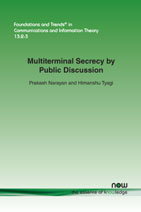Multiterminal Secrecy by Public Discussion
By Prakash Narayan, University of Maryland, College Park, USA, prakash@umd.edu | Himanshu Tyagi, Indian Institute of Science, Bangalore, India, htyagi@ece.iisc.ernet.in
Abstract
This monograph describes principles of information theoretic secrecy generation by legitimate parties with public discussion in the presence of an eavesdropper. The parties are guaranteed secrecy in the form of independence from the eavesdropper’s observation of the communication. Part I develops basic technical tools for secrecy generation, many of which are potentially of independent interest beyond secrecy settings. Various information theoretic and cryptographic notions of secrecy are compared. Emphasis is placed on central themes of interactive communication and common randomness as well as on core methods of balanced coloring and leftover hash for extracting secret uniform randomness. Achievability and converse results are shown to emerge from “single shot” incarnations that serve to explain essential structure. Part II applies the methods of Part I to secrecy generation in two settings: a multiterminal source model and a multiterminal channel model, in both of which the legitimate parties are afforded privileged access to correlated observations of which the eavesdropper has only partial knowledge. Characterizations of secret key capacity bring out inherent connections to the data compression concept of omniscience and, for a specialized source model, to a combinatorial problem of maximal spanning tree packing in a multigraph. Interactive common information is seen to govern the minimum rate of communication needed to achieve secret key capacity in the two-terminal source model. Furthermore, necessary and sufficient conditions are analyzed for the secure computation of a given function in the multiterminal source model. Based largely on known recent results, this self-contained monograph also includes new formulations with associated new proofs. Supplementing each chapter in Part II are descriptions of several open problems.
Multiterminal Secrecy by Public Discussion
This monograph describes the principles of information theoretic secrecy generation by legitimate parties with public discussion in the presence of an eavesdropper. The parties are guaranteed secrecy in the form of independence from the eavesdropper’s observation of the communication. The focus is on secrecy generation in two settings: a multiterminal source model and a multiterminal channel model, in both of which the legitimate parties are given privileged access to correlated data of which the eavesdropper has only partial knowledge.
Part I is concerned with basic technical tools for secrecy generation, many of which are potentially of independent interest beyond secrecy settings. Part II applies the methods of Part I to secrecy generation for the multiterminal source and channel models.
Based largely on known recent results, this self-contained tutorial also includes new formulations with associated new proofs.
